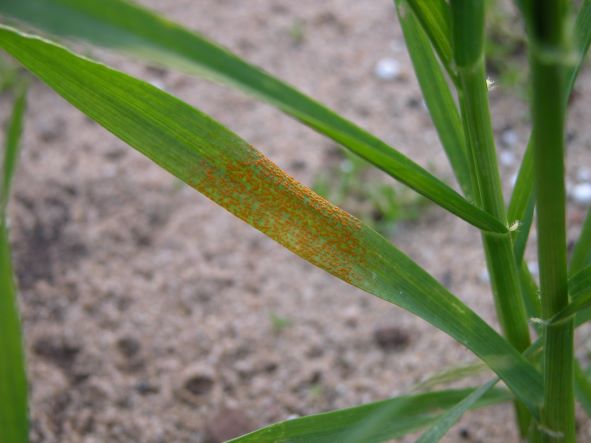
By Shafiya Hussein, Grains Biosecurity Officer, South Australia
If rusts are not managed this season wheat growers risk losing up to 75% of their potential yield in susceptible varieties.
Wheat is the primary grain crop produced in South Australia, with almost 4 million tonnes produced in 2021 and 4.62 million tonnes forecasted this year.
Wheat rust poses a serious threat to crop production and it is essential to be vigilant and regularly monitor wheat to protect the industry.
The frequency of isolated wheat rust incursions in Australia has increased over the past two decades. Previous wheat rust introductions amounted to $1.8 (1973) – $2.7 (2015) billion in control costs and yield loss.
What are wheat rusts?
Wheat rusts are common fungal diseases caused by three different species of the genus Puccinia. The three different types of wheat rusts are leaf rust, stripe rust and stem rust.
Rust diseases reduce wheat quality and can cause significant yield losses (20-75%) in the absence of preventative fungicide applications to moderately susceptible – susceptible (MS-S) wheat crops. They are adaptable and can mutate and hybridise to evolve in new and more virulent pathotypes that overcome resistant varieties.
Rust spores are primarily air-borne but may also be transported via clothing, used farm machinery, equipment, and vehicles. Exotic strains can be accidentally introduced from overseas, however rusts can only reproduce on a living host.
Where has wheat rust been detected?
Stripe rust of wheat was detected on the Yorke Peninsula, and leaf rust on Eyre Peninsula, in early-mid August 2022. As a result, South Australian grain growers are urged to monitor their crops regularly for all three wheat rust diseases. Rain, humidity, and high temperatures are ideal conditions for high inoculum pressure in 2022.
Researching rust disease with resistant varieties.
The Grains Research and Development Corporation (GRDC) has collaborated with government, universities and research institutes on genetic markers for rust resistance and the development of resistance genes. In addition, the University of Sydney, conducts national surveys to monitor the occurrence of rust pathotypes and their impact on current varieties. It also identifies new rust resistance genes for cereal breeders and conducts germplasm screening and enhancement to support breeding and cereal research companies.
How to avoid wheat rust
The most economical way to control rust diseases and avoid crop losses, is to grow resistant wheat varieties. Preventative fungicides when applied early in an epidemic have proven to be the most effective against rusts. Propiconazole, Tebuconazole and triadimefon are commonly used in South Australia, but there are a range of different actives on the market and these should be rotated to avoid the potential for development of resistance.
Rust spores can survive on volunteer cereals and some grasses in between growing seasons. Therefore, regular monitoring and maintenance of ‘green-bridges’ is important to control the spread of pests and diseases.
Implementing measures from the Grains Farm Biosecurity Program (GFBP) also minimises the entry and spread of rust on your property. Ensure you maintain a visitor logbook and designated parking zones for vehicles. Cleaning and checking used machinery and equipment before being delivered to your property is also essential.
What to do if you suspect wheat rust
Identifying and monitoring rust pathotypes is critical to protecting your industry. Collect suspected fresh rust-infected wheat samples in paper bags and send them to: The Australia Cereal Rust Survey, University of Sydney, Australian Rust Survey, Reply Paid 88076, Narellan, NSW, 2567.
Refer to the Australian Cereal Rust Survey – Faculty of Science (sydney.edu.au) for appropriate sampling and infected sample dispatch guidelines. Ongoing vigilance is a key part of any on-farm grains biosecurity program. Report anything new or unusual on your property to the Emergency Plant Pest Hotline 1800 084 881.
Plant Health Australia (PHA) has developed a fact sheet about wheat stem rust.
The GFBP is an initiative of the Department of Primary Industries and Regions South Australia, PHA, and Grain Producers Australia to improve the management of, and preparedness for, biosecurity risks in the grains industry at the farm and industry levels.
The Grains Farm Biosecurity website offers practical resources for producers that include fact sheets, videos, how to guides, online training and strategies to assist in the management of grains farm biosecurity risks.
For more information and advice on South Australian grains farm biosecurity practices, please contact Shafiya Hussein Shafiya.Hussein@sa.gov.au